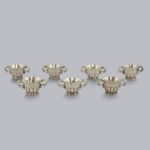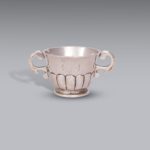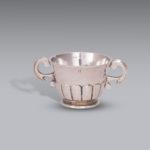
Seven Cups, 1657 [Si74]
London, 1657; maker’s mark of a Hound Sejant (Richard Blackwell the Younger)
Silver: H. of each approx. 4.8 cm, D. 6.4 cm, 833 g (total weight)
Engraved with the arms of Wykeham.
There were originally eight of these small cups, probably made for drinking toasts, but one was lost in about 1750. Only one other set of similar cups survives from the seventeenth century (Queens’ College, Oxford, 1677, set of 12).
Long known only from his mark as the ‘Hound Sejant Maker’, the silversmith was identified in 2003 as Richard Blackwell the Younger. His father, Richard Blackwell the Elder, was a leading silversmith active from the 1600s to the 1640s. The younger Richard Blackwell was sworn to the Ordinances in 1646, but only became free of the Merchant Taylors’ Company by patrimony in 1649. Mitchell (Silversmiths in Elizabethan and Stuart London) lists 20 pieces by Blackwell the Younger, not including the Winchester cups, dated from 1646/7 to 1666/7. He seems to have specialised in drinking cups and communion plate, much of it produced for the private chapels of Anglican families during the Interregnum. One other piece in the Winchester Collection (Si17) was also made by Blackwell.
Literature: Margaret Toynbee, ‘King Charles I and Winchester College’, Proceedings of the Hampshire Field Club and Archaeological Society, 18:1 (1953), p. 26; Charles Oman, ‘The Winchester College Plate’, The Connoisseur (January, 1962), p. 29 (illustrated); Charles Oman, Caroline Silver, 1625-1688 (London, 1970), p. 42, plate 20B; Michael Clayton, Collectors Dictionary of the Silver and Gold of Great Britain and North America (New York, 1985), p. 124; R. Foster, Winchester College Treasury: a guide to the collections (Winchester, 2016), p. 21.
Provenance: Commissioned by the College, 1657.
Location: Treasury, Gallery 1 (2); Hatches (5).


